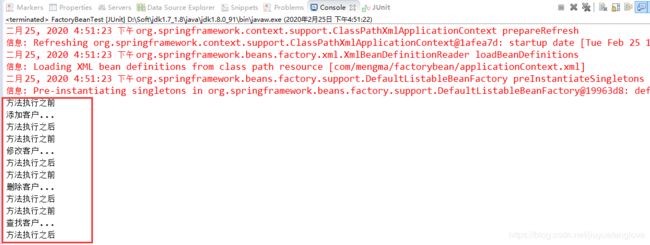- Spring MVC 全面指南:从入门到精通的详细解析
一杯梅子酱
技术栈学习springmvcjava
引言:SpringMVC,作为Spring框架的一个重要模块,为构建Web应用提供了强大的功能和灵活性。无论是初学者还是有一定经验的开发者,掌握SpringMVC都将显著提升你的Web开发技能。本文旨在为初学者提供一个全面且易于理解的学习路径,通过详细的知识点分析和实际案例,帮助你快速上手SpringMVC,让学习过程既深刻又高效。一、SpringMVC简介1.1什么是SpringMVC?Spri
- 【Java】已解决:org.springframework.jdbc.datasource.lookup.DataSourceLookupFailureException
屿小夏
java开发语言
文章目录一、分析问题背景问题背景描述出现问题的场景二、可能出错的原因三、错误代码示例四、正确代码示例五、注意事项已解决:org.springframework.jdbc.datasource.lookup.DataSourceLookupFailureException在使用Spring框架进行开发时,数据源的配置和使用是非常关键的一环。然而,有时候我们可能会遇到org.springframewo
- Java中的服务端点响应缓存:Spring Cache抽象
微赚淘客机器人开发者联盟@聚娃科技
java缓存spring
Java中的服务端点响应缓存:SpringCache抽象大家好,我是微赚淘客返利系统3.0的小编,是个冬天不穿秋裤,天冷也要风度的程序猿!在Java后端服务开发中,缓存是一个重要的性能优化手段。Spring框架提供了一个强大的缓存抽象,允许开发者以统一的方式使用不同的缓存技术。本文将介绍如何在Java应用中使用SpringCache抽象来实现服务端点的响应缓存。响应缓存的重要性响应缓存在服务端点中
- Java Spring Boot 全面教程
极客代码
玩转Javajavaspringboot开发语言后端
一、SpringBoot简介与环境搭建1.1SpringBoot简介SpringBoot是一种基于Java的开源框架,由PivotalSoftware开发,旨在简化新Spring应用程序的初始化、配置和部署过程。它遵循约定优于配置的原则,通过内嵌的Tomcat、Jetty或Undertow等容器,使得开发者能够快速构建独立运行的、生产级别的基于Spring框架的应用程序。SpringBoot包含了
- Spring6学习笔记4:事务
·云扬·
SSMJava#Spring学习笔记spring
1JdbcTemplate1.1简介Spring框架对JDBC进行封装,使用JdbcTemplate方便实现对数据库操作准备工作①搭建子模块搭建子模块:spring-jdbc-tx②加入依赖org.springframeworkspring-jdbc6.0.2mysqlmysql-connector-java8.0.30com.alibabadruid1.2.15③创建jdbc.propertie
- 【Spring】Spring中@Component和@Bean的区别?
九师兄
框架-springbootspringjava后端
1.概述在Spring框架中,@Component和@Bean是两个常用的注解,用于实现组件的声明和配置。它们的主要区别如下:作用对象不同:@Component注解用于声明一个类为Spring容器的组件(Bean),Spring会自动扫描并将其实例化为Bean并管理。@Bean注解用于在配置类(通常是带有@Configuration注解的类)中声明一个方法,该方法的返回值将被注册为Spring容器
- 【Java】已解决:org.springframework.dao.DataAccessException
屿小夏
javaoracle数据库
文章目录一、分析问题背景二、可能出错的原因三、错误代码示例四、正确代码示例五、注意事项已解决:org.springframework.dao.DataAccessException一、分析问题背景在Spring框架中,org.springframework.dao.DataAccessException是一个常见的异常类型,通常出现在与数据库交互的过程中。当应用程序尝试执行数据库操作(例如查询、插
- Spring Boot整合Spring Security+JWT+OAuth 2.0 实现认证鉴权登录(框架介绍)
星空下夜猫子
springspringboot数据库
简介SpringSecurity框架描述SpringSecurity是一个基于Spring框架的安全性框架,可以为Web应用程序提供身份验证(Authentication)、授权(Authorization)、攻击防御等安全功能。SpringSecurity框架提供了一整套的身份验证、授权、ACL(访问控制列表)等模块和类库,还提供了一系列的安全过滤器、安全标签等,可以方便地实现常见的安全性控制。
- Spring事务传播行为详解(超详细)
yuans_
springspring事务传播行为
文章出自:Spring事务传播行为详解前言Spring在TransactionDefinition接口中规定了7种类型的事务传播行为。事务传播行为是Spring框架独有的事务增强特性,他不属于的事务实际提供方数据库行为。这是Spring为我们提供的强大的工具箱,使用事务传播行可以为我们的开发工作提供许多便利。但是人们对他的误解也颇多,你一定也听过“service方法事务最好不要嵌套”的传言。要想正
- Spring事务传播行为详解
Aries263
spring数据库java
在Spring框架中,事务管理是一个至关重要的部分,它确保了数据的一致性和完整性。Spring提供了灵活的事务传播行为,允许开发者根据具体场景选择不同的事务管理方式。本文将详细介绍Spring的七种事务传播行为,并通过示例代码来展示它们的具体应用。1.Spring事务传播行为概述Spring事务的传播行为定义了当一个事务方法被另一个事务方法调用时,两个方法之间的事务应该如何协调和传播。Spring
- Spring如何进行动态注册Bean
小园子的小菜
javajava开发语言
在Spring框架中,Bean是应用程序的核心组成部分,而BeanDefinition则是这些Bean的元数据表示。随着应用程序的复杂性增加,我们可能需要更灵活地定义和注册Bean。Spring框架提供了几个扩展点,允许我们以编程方式影响Bean的创建和定义过程。本文将深入探讨BeanDefinitionRegistryPostProcessor、ImportBeanDefinitionRegis
- SpringBoot : SpringBoot自定义的ApplicationContext实现类
九师兄
框架-springboot
文章目录1.美图2.概述3.在传统spring框架下的扩展方式4.探寻SpringBoot框架下的扩展方式5.如何设置自定义的ApplicationContext实现类6.实战使用自定义的ApplicationContext实现类1.美图2.概述在学习spring容器初始化的过程中,发现spring容器预留了一些扩展点,我们可以写子类来做功能扩展,例如AbstractApplicationCont
- 深入探究 Spring 的扫描原理
小园子的小菜
javaspringjavamysql
在Spring框架中,扫描机制是其核心功能之一,它负责在应用程序启动时自动发现和注册相关的组件。本文将深入探讨Spring的扫描原理,包括扫描过程以及相关源码的分析。spring提供了两种扫描方式来进行扫描:1.我们可以通过AnnotationConfigApplicationContext的scan方法中进行设置固定的包名路径;2.我们可以通过@ComponentScan注解来进行配置要进行扫描
- 短视频矩阵源码
fendou--yx898978
抖音账号矩阵系统源码开发python开发语言矩阵
矩阵系统源码主要有三种框架:Spring、Struts和Hibernate。Spring框架是一个全栈式的Java应用程序开发框架,提供了IOC容器、AOP、事务管理等功能。Struts框架是一个MVC架构的Web应用程序框架,用于将数据模型、Web应用程序的用户界面和控制器逻辑分离。Hibernate框架是一个面向对象的数据库访问框架,提供了ORM(对象关系映射)机制,允许开发人员使用面向对象的
- Java项目中参数校验方法
DebugDiver代码深处潜水员
项目相关javapython开发语言
Java项目中参数校验方法1.参数校验的重要性2.常见的参数校验方法2.1使用`assert`关键字2.2使用`Objects.requireNonNull`2.3使用自定义异常2.4使用`Preconditions`类2.5使用HibernateValidator注解2.6使用Spring框架内的验证2.7使用JSR303/349(BeanValidation)2.8使用ApacheCommon
- 基于java+ssm+vue毕业设计源码合集(1-100)源码+文档+调试+讲解
小程序设计
javajava课程设计vue.js
技术栈介绍:SSM(Spring、SpringMVC、MyBatis)框架搭配Vue前端框架是当前较为流行的项目开发技术栈。以下是详细的技術列表:1.后端技术:-Spring:一个开源的Java平台,提供了用于构建企业级应用程序的全面解决方案。-SpringMVC:Spring框架的一个子项目,用于构建Web应用程序,提供了处理请求、数据验证、视图解析等功能的模块。-MyBatis:一个优秀的持久
- Spring Cloud与Spring Boot有什么关系?
用心去追梦
springcloudspringbootspring
SpringCloud和SpringBoot都是由Pivotal团队(原SpringSource)开发的,它们之间有着密切的关系,但也有各自的特点和用途。下面我将详细介绍这两个项目之间的关系以及它们各自的定位。SpringBootSpringBoot是一个基于Spring框架的子项目,它旨在简化Spring应用程序的创建和部署。SpringBoot提供了以下特点:开箱即用:自动配置Spring应用
- Spring Boot 和 Spring Framework 的区别是什么?
程序员黄同学
springspringboot后端
SpringFramework和SpringBoot都是为了解决在Java开发过程中遇到的各种问题而出现的。了解它们之间的差异,能够更好的帮助我们使用它们。SpringFrameworkSpringFramework是一个开源的Java平台,它提供了一种全面的架构和基础设施来支持Java应用程序的开发。其主要设计目标是:使得J2EE开发更容易使用,降低Java开发的复杂性。Spring框架以其核心
- @rabbitlistener注解
小小懒懒
RabbitMQ
@RabbitListener是SpringAMQP(AdvancedMessageQueuingProtocol)框架中的一个注解,用于创建RabbitMQ消息监听器。RabbitMQ是一个开源的消息代理和队列服务器,它实现了AMQP协议,用于在分布式系统中进行消息传递。SpringAMQP是Spring框架对RabbitMQ的集成,提供了方便的消息发送和接收的功能。通过使用@RabbitLis
- Spring Boot 自动配置
Flying_Fish_Xuan
springboot后端java
SpringBoot自动配置详解SpringBoot是一种基于Spring框架的快速开发工具,提供了诸多便捷的功能,其中自动配置是其核心特性之一。自动配置大幅简化了Spring应用的开发过程,开发者无需手动编写繁琐的配置文件,SpringBoot会根据项目的依赖、运行环境以及类路径中的组件自动进行适当的配置。1.SpringBoot自动配置概述在传统的Spring应用中,开发者通常需要手动编写大量
- 5、设计与实现资源加载器,从Spring.xml解析和注册Bean对象
大树~~
#Spring手写系列数据库java开发语言spring后端
在Spring框架的核心设计中,Bean工厂和资源加载器是两个非常重要的模块。理解它们的设计和实现对于掌握Spring的核心机制具有重要意义。在这篇文章中,我们将详细探讨Spring框架中Bean工厂的设计原理、资源加载的实现机制、如何解析Bean定义并将其注册到Spring容器中。通过这些内容,读者不仅能够理解Spring框架的设计思想,还能够借鉴这些设计模式来优化自己的代码架构。一、前言在实际
- BeanFactory 和 ApplicationContext
码了三年又三年
JavaSpringjava前端开发语言
1.BeanFactory和ApplicationContext都是spring框架提供的接口。2.BeanFactory接口是spring容器中最底层(顶层)的接口,面向spring框架,很多的内部的工厂类都实现该接口;ApplicationContext接口继承了BeanFactory接口,面向应用程序,提供额外的功能。3.实现了BeanFactory接口的工厂类,在使用某个对象时才会去创建初
- 【Java】已解决:org.springframework.transaction.TransactionTimedOutException
屿小夏
java数据库开发语言
文章目录一、分析问题背景场景描述二、可能出错的原因三、错误代码示例四、正确代码示例五、注意事项已解决:org.springframework.transaction.TransactionTimedOutException一、分析问题背景在Spring框架中,TransactionTimedOutException是一种常见的事务超时异常。通常,这种异常发生在数据库操作时间超过了预设的事务超时时间
- java multipartfile读取文件
Picky酱
java开发语言
使用JavaMultipartFile读取文件在Java中,我们经常需要处理文件上传和下载的操作。而Spring框架提供了MultipartFile接口来处理文件上传,通过这个接口我们可以方便地读取上传的文件内容。MultipartFile概述MultipartFile接口是Spring框架中用于处理文件上传的接口,它提供了一些方法来获取文件的信息和内容。通过MultipartFile接口,我们可
- Spring MVC 架构详解
firepation
SpringJavaspringmvc
SpringMVC(Model-View-Controller)是Spring框架中用于构建Web应用程序的模块。它通过分离应用程序的不同方面(输入逻辑、业务逻辑和UI逻辑)来简化开发工作。本文将详细介绍SpringMVC架构及其基本组件,包括DispatcherServlet、HandlerMapping、Controller和ViewResolver。SpringMVC架构SpringMVC架
- 【Java】已解决:org.springframework.beans.factory.NoUniqueBeanDefinitionException非唯一Bean定义异常
屿小夏
java开发语言
文章目录一、分析问题背景二、可能出错的原因三、错误代码示例四、正确代码示例五、注意事项已解决:org.springframework.beans.factory.NoUniqueBeanDefinitionException非唯一Bean定义异常一、分析问题背景在Spring框架的开发过程中,开发者可能会遇到org.springframework.beans.factory.NoUniqueBea
- Spring Boot项目中如何解决循环依赖
潘多编程
springbootjavaspring
在SpringBoot项目中,循环依赖是一个常见的问题,尤其是在构建复杂的微服务架构时。当两个或多个Bean相互持有对方的引用时,就会形成循环依赖。Spring框架通过不同的机制来解决这个问题,以保证应用程序能够正确地启动并运行。下面我们将探讨几种处理循环依赖的方法,同时也深入了解一下Spring是如何处理Bean的初始化过程的。SpringBean的初始化过程在Spring容器中,Bean的生命
- Spring基础
zzzzzzzziu
springjava后端
前言Spring是一个开源的Java平台,用于构建企业级应用程序。它提供了一系列的模块和工具,以简化Java应用程序的开发。Spring框架的核心特点是轻量级、灵活性和可扩展性。以下是Spring基础知识的详细概述:Spring概述开源框架:Spring是一个开源的Java平台,广泛用于企业级应用开发。核心特性:Spring通过依赖注入(DI)和面向切面编程(AOP)等技术,降低了组件之间的耦合度
- Spring Boot
zzzzzzzziu
springboot后端java
引言SpringBoot是基于Spring框架基础上推出的一个全新的框架,旨在让开发者可以轻松地创建一个可独立运行的、生产级别的应用程序。以下是关于SpringBoot的详细解析:SpringBoot的简介SpringBoot是由Pivotal团队提供的全新框架,其设计目的是用来简化Spring应用的初始搭建以及开发过程。SpringBoot通过大量的默认配置和自动化配置,让开发者可以快速搭建并运
- SpringMVC基础
zzzzzzzziu
spring
引言SpringMVC是Spring框架提供的一个基于MVC(Model-View-Controller)模式的轻量级Web开发框架。它作为Spring为表示层(UI)开发提供的一整套完备的解决方案,具有许多显著的特点和优势。以下是对SpringMVC的详细解析:SpringMVC的基本概念MVC模式:MVC是一种将应用程序分为三个核心部分(模型、视图、控制器)的软件设计模式。SpringMVC严
- ztree异步加载
3213213333332132
JavaScriptAjaxjsonWebztree
相信新手用ztree的时候,对异步加载会有些困惑,我开始的时候也是看了API花了些时间才搞定了异步加载,在这里分享给大家。
我后台代码生成的是json格式的数据,数据大家按各自的需求生成,这里只给出前端的代码。
设置setting,这里只关注async属性的配置
var setting = {
//异步加载配置
- thirft rpc 具体调用流程
BlueSkator
中间件rpcthrift
Thrift调用过程中,Thrift客户端和服务器之间主要用到传输层类、协议层类和处理类三个主要的核心类,这三个类的相互协作共同完成rpc的整个调用过程。在调用过程中将按照以下顺序进行协同工作:
(1) 将客户端程序调用的函数名和参数传递给协议层(TProtocol),协议
- 异或运算推导, 交换数据
dcj3sjt126com
PHP异或^
/*
* 5 0101
* 9 1010
*
* 5 ^ 5
* 0101
* 0101
* -----
* 0000
* 得出第一个规律: 相同的数进行异或, 结果是0
*
* 9 ^ 5 ^ 6
* 1010
* 0101
* ----
* 1111
*
* 1111
* 0110
* ----
* 1001
- 事件源对象
周华华
JavaScript
<!DOCTYPE html PUBLIC "-//W3C//DTD XHTML 1.0 Transitional//EN" "http://www.w3.org/TR/xhtml1/DTD/xhtml1-transitional.dtd">
<html xmlns="http://www.w3.org/1999/xhtml&q
- MySql配置及相关命令
g21121
mysql
MySQL安装完毕后我们需要对它进行一些设置及性能优化,主要包括字符集设置,启动设置,连接优化,表优化,分区优化等等。
一 修改MySQL密码及用户
- [简单]poi删除excel 2007超链接
53873039oycg
Excel
采用解析sheet.xml方式删除超链接,缺点是要打开文件2次,代码如下:
public void removeExcel2007AllHyperLink(String filePath) throws Exception {
OPCPackage ocPkg = OPCPac
- Struts2添加 open flash chart
云端月影
准备以下开源项目:
1. Struts 2.1.6
2. Open Flash Chart 2 Version 2 Lug Wyrm Charmer (28th, July 2009)
3. jofc2,这东西不知道是没做好还是什么意思,好像和ofc2不怎么匹配,最好下源码,有什么问题直接改。
4. log4j
用eclipse新建动态网站,取名OFC2Demo,将Struts2 l
- spring包详解
aijuans
spring
下载的spring包中文件及各种包众多,在项目中往往只有部分是我们必须的,如果不清楚什么时候需要什么包的话,看看下面就知道了。 aspectj目录下是在Spring框架下使用aspectj的源代码和测试程序文件。Aspectj是java最早的提供AOP的应用框架。 dist 目录下是Spring 的发布包,关于发布包下面会详细进行说明。 docs&nb
- 网站推广之seo概念
antonyup_2006
算法Web应用服务器搜索引擎Google
持续开发一年多的b2c网站终于在08年10月23日上线了。作为开发人员的我在修改bug的同时,准备了解下网站的推广分析策略。
所谓网站推广,目的在于让尽可能多的潜在用户了解并访问网站,通过网站获得有关产品和服务等信息,为最终形成购买决策提供支持。
网站推广策略有很多,seo,email,adv
- 单例模式,sql注入,序列
百合不是茶
单例模式序列sql注入预编译
序列在前面写过有关的博客,也有过总结,但是今天在做一个JDBC操作数据库的相关内容时 需要使用序列创建一个自增长的字段 居然不会了,所以将序列写在本篇的前面
1,序列是一个保存数据连续的增长的一种方式;
序列的创建;
CREATE SEQUENCE seq_pro
2 INCREMENT BY 1 -- 每次加几个
3
- Mockito单元测试实例
bijian1013
单元测试mockito
Mockito单元测试实例:
public class SettingServiceTest {
private List<PersonDTO> personList = new ArrayList<PersonDTO>();
@InjectMocks
private SettingPojoService settin
- 精通Oracle10编程SQL(9)使用游标
bijian1013
oracle数据库plsql
/*
*使用游标
*/
--显示游标
--在显式游标中使用FETCH...INTO语句
DECLARE
CURSOR emp_cursor is
select ename,sal from emp where deptno=1;
v_ename emp.ename%TYPE;
v_sal emp.sal%TYPE;
begin
ope
- 【Java语言】动态代理
bit1129
java语言
JDK接口动态代理
JDK自带的动态代理通过动态的根据接口生成字节码(实现接口的一个具体类)的方式,为接口的实现类提供代理。被代理的对象和代理对象通过InvocationHandler建立关联
package com.tom;
import com.tom.model.User;
import com.tom.service.IUserService;
- Java通信之URL通信基础
白糖_
javajdkwebservice网络协议ITeye
java对网络通信以及提供了比较全面的jdk支持,java.net包能让程序员直接在程序中实现网络通信。
在技术日新月异的现在,我们能通过很多方式实现数据通信,比如webservice、url通信、socket通信等等,今天简单介绍下URL通信。
学习准备:建议首先学习java的IO基础知识
URL是统一资源定位器的简写,URL可以访问Internet和www,可以通过url
- 博弈Java讲义 - Java线程同步 (1)
boyitech
java多线程同步锁
在并发编程中经常会碰到多个执行线程共享资源的问题。例如多个线程同时读写文件,共用数据库连接,全局的计数器等。如果不处理好多线程之间的同步问题很容易引起状态不一致或者其他的错误。
同步不仅可以阻止一个线程看到对象处于不一致的状态,它还可以保证进入同步方法或者块的每个线程,都看到由同一锁保护的之前所有的修改结果。处理同步的关键就是要正确的识别临界条件(cri
- java-给定字符串,删除开始和结尾处的空格,并将中间的多个连续的空格合并成一个。
bylijinnan
java
public class DeleteExtraSpace {
/**
* 题目:给定字符串,删除开始和结尾处的空格,并将中间的多个连续的空格合并成一个。
* 方法1.用已有的String类的trim和replaceAll方法
* 方法2.全部用正则表达式,这个我不熟
* 方法3.“重新发明轮子”,从头遍历一次
*/
public static v
- An error has occurred.See the log file错误解决!
Kai_Ge
MyEclipse
今天早上打开MyEclipse时,自动关闭!弹出An error has occurred.See the log file错误提示!
很郁闷昨天启动和关闭还好着!!!打开几次依然报此错误,确定不是眼花了!
打开日志文件!找到当日错误文件内容:
--------------------------------------------------------------------------
- [矿业与工业]修建一个空间矿床开采站要多少钱?
comsci
地球上的钛金属矿藏已经接近枯竭...........
我们在冥王星的一颗卫星上面发现一些具有开采价值的矿床.....
那么,现在要编制一个预算,提交给财政部门..
- 解析Google Map Routes
dai_lm
google api
为了获得从A点到B点的路劲,经常会使用Google提供的API,例如
[url]
http://maps.googleapis.com/maps/api/directions/json?origin=40.7144,-74.0060&destination=47.6063,-122.3204&sensor=false
[/url]
从返回的结果上,大致可以了解应该怎么走,但
- SQL还有多少“理所应当”?
datamachine
sql
转贴存档,原帖地址:http://blog.chinaunix.net/uid-29242841-id-3968998.html、http://blog.chinaunix.net/uid-29242841-id-3971046.html!
------------------------------------华丽的分割线--------------------------------
- Yii使用Ajax验证时,如何设置某些字段不需要验证
dcj3sjt126com
Ajaxyii
经常像你注册页面,你可能非常希望只需要Ajax去验证用户名和Email,而不需要使用Ajax再去验证密码,默认如果你使用Yii 内置的ajax验证Form,例如:
$form=$this->beginWidget('CActiveForm', array( 'id'=>'usuario-form',&
- 使用git同步网站代码
dcj3sjt126com
crontabgit
转自:http://ued.ctrip.com/blog/?p=3646?tn=gongxinjun.com
管理一网站,最开始使用的虚拟空间,采用提供商支持的ftp上传网站文件,后换用vps,vps可以自己搭建ftp的,但是懒得搞,直接使用scp传输文件到服务器,现在需要更新文件到服务器,使用scp真的很烦。发现本人就职的公司,采用的git+rsync的方式来管理、同步代码,遂
- sql基本操作
蕃薯耀
sqlsql基本操作sql常用操作
sql基本操作
>>>>>>>>>>>>>>>>>>>>>>>>>>>>>>>>>>>>
蕃薯耀 2015年6月1日 17:30:33 星期一
&
- Spring4+Hibernate4+Atomikos3.3多数据源事务管理
hanqunfeng
Hibernate4
Spring3+后不再对JTOM提供支持,所以可以改用Atomikos管理多数据源事务。Spring2.5+Hibernate3+JTOM参考:http://hanqunfeng.iteye.com/blog/1554251Atomikos官网网站:http://www.atomikos.com/ 一.pom.xml
<dependency>
<
- jquery中两个值得注意的方法one()和trigger()方法
jackyrong
trigger
在jquery中,有两个值得注意但容易忽视的方法,分别是one()方法和trigger()方法,这是从国内作者<<jquery权威指南》一书中看到不错的介绍
1) one方法
one方法的功能是让所选定的元素绑定一个仅触发一次的处理函数,格式为
one(type,${data},fn)
&nb
- 拿工资不仅仅是让你写代码的
lampcy
工作面试咨询
这是我对团队每个新进员工说的第一件事情。这句话的意思是,我并不关心你是如何快速完成任务的,哪怕代码很差,只要它像救生艇通气门一样管用就行。这句话也是我最喜欢的座右铭之一。
这个说法其实很合理:我们的工作是思考客户提出的问题,然后制定解决方案。思考第一,代码第二,公司请我们的最终目的不是写代码,而是想出解决方案。
话粗理不粗。
付你薪水不是让你来思考的,也不是让你来写代码的,你的目的是交付产品
- 架构师之对象操作----------对象的效率复制和判断是否全为空
nannan408
架构师
1.前言。
如题。
2.代码。
(1)对象的复制,比spring的beanCopier在大并发下效率要高,利用net.sf.cglib.beans.BeanCopier
Src src=new Src();
BeanCopier beanCopier = BeanCopier.create(Src.class, Des.class, false);
- ajax 被缓存的解决方案
Rainbow702
JavaScriptjqueryAjaxcache缓存
使用jquery的ajax来发送请求进行局部刷新画面,各位可能都做过。
今天碰到一个奇怪的现象,就是,同一个ajax请求,在chrome中,不论发送多少次,都可以发送至服务器端,而不会被缓存。但是,换成在IE下的时候,发现,同一个ajax请求,会发生被缓存的情况,只有第一次才会被发送至服务器端,之后的不会再被发送。郁闷。
解决方法如下:
① 直接使用 JQuery提供的 “cache”参数,
- 修改date.toLocaleString()的警告
tntxia
String
我们在写程序的时候,经常要查看时间,所以我们经常会用到date.toLocaleString(),但是date.toLocaleString()是一个过时 的API,代替的方法如下:
package com.tntxia.htmlmaker.util;
import java.text.SimpleDateFormat;
import java.util.
- 项目完成后的小总结
xiaomiya
js总结项目
项目完成了,突然想做个总结但是有点无从下手了。
做之前对于客户端给的接口很模式。然而定义好了格式要求就如此的愉快了。
先说说项目主要实现的功能吧
1,按键精灵
2,获取行情数据
3,各种input输入条件判断
4,发送数据(有json格式和string格式)
5,获取预警条件列表和预警结果列表,
6,排序,
7,预警结果分页获取
8,导出文件(excel,text等)
9,修

